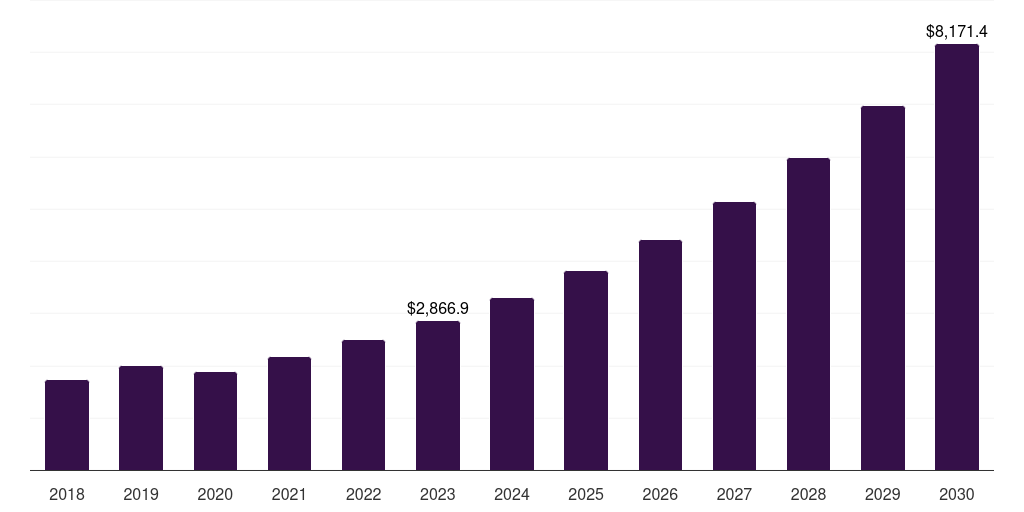China Non-invasive Aesthetic Treatment Market Size & Outlook
China non-invasive aesthetic treatment market, 2018-2030 (US$M)

Related Markets
China non-invasive aesthetic treatment market highlights
- The China non-invasive aesthetic treatment market generated a revenue of USD 2,866.9 million in 2023 and is expected to reach USD 8,171.4 million by 2030.
- The China market is expected to grow at a CAGR of 16.1% from 2024 to 2030.
- In terms of segment, injectables was the largest revenue generating procedures in 2023.
- Injectables is the most lucrative procedures segment registering the fastest growth during the forecast period.
Non-invasive aesthetic treatment market data book summary
| Market revenue in 2023 | USD 2,866.9 million |
| Market revenue in 2030 | USD 8,171.4 million |
| Growth rate | 16.1% (CAGR from 2023 to 2030) |
| Largest segment | Injectables |
| Fastest growing segment | Injectables |
| Historical data | 2018 - 2022 |
| Base year | 2023 |
| Forecast period | 2024 - 2030 |
| Quantitative units | Revenue in USD million |
| Market segmentation | Injectables, Skin Rejuvenation |
| Key market players worldwide | Hologic Inc, AbbVie Inc, Galderma Group AG Registered Shares, Alma Lasers Ltd, UltraShape Ltd. (Syneron Medical), Johnson & Johnson, Merz Pharma, Lumenis, Bausch Health Companies Inc, Cutera Inc, Revance Therapeutics Inc |
Other key industry trends
- In terms of revenue, China accounted for 4.1% of the global non-invasive aesthetic treatment market in 2023.
- Country-wise, U.S. is expected to lead the global market in terms of revenue in 2030.
- In Asia Pacific, Japan non-invasive aesthetic treatment market is projected to lead the regional market in terms of revenue in 2030.
- India is the fastest growing regional market in Asia Pacific and is projected to reach USD 6,512.1 million by 2030.
No credit card required*
Horizon in a snapshot
- 30K+ Global Market Reports
- 120K+ Country Reports
- 1.2M+ Market Statistics
- 200K+ Company Profiles
- Industry insights and more
Non-invasive Aesthetic Treatment Market Scope
Non-invasive Aesthetic Treatment Market Companies
| Name | Profile | # Employees | HQ | Website |
|---|
China non-invasive aesthetic treatment market outlook
The databook is designed to serve as a comprehensive guide to navigating this sector. The databook focuses on market statistics denoted in the form of revenue and y-o-y growth and CAGR across the globe and regions. A detailed competitive and opportunity analyses related to non-invasive aesthetic treatment market will help companies and investors design strategic landscapes.
Injectables was the largest segment with a revenue share of 62.95% in 2023. Horizon Databook has segmented the China non-invasive aesthetic treatment market based on injectables, skin rejuvenation covering the revenue growth of each sub-segment from 2018 to 2030.
Growth of non-invasive aesthetic treatment market in China can be attributed to increasing demand for antiaging and antipollution skin care products. Nearly 23% of population in China is geriatric, which is expected to boost adoption of noninvasive aesthetic treatments, leading to market growth.
The buying power of China’s growing middle-class population is increasing, and the local population is more inclined to buy quality products, making the country world’s second largest aesthetic market after the U.S. In China, the number of aesthetic and lip augmentation procedures is increasing significantly by a staggering 7.9% per year, according to the South China Morning Post.
Moreover, social media apps, such as Meitu, Instagram, WeChat, and Snapchat, have changed the way people in China perceive their appearance. In 2018, there were about 20 million medical aesthetic consumers, of which about 64% were born after 1990 and around 19% were postmillennial, according to a report by So-Young, a NASDAQ-listed online plastic surgery marketplace, in China.
Reasons to subscribe to China non-invasive aesthetic treatment market databook:
-
Access to comprehensive data: Horizon Databook provides over 1 million market statistics and 20,000+ reports, offering extensive coverage across various industries and regions.
-
Informed decision making: Subscribers gain insights into market trends, customer preferences, and competitor strategies, empowering informed business decisions.
-
Cost-Effective solution: It's recognized as the world's most cost-effective market research database, offering high ROI through its vast repository of data and reports.
-
Customizable reports: Tailored reports and analytics allow companies to drill down into specific markets, demographics, or product segments, adapting to unique business needs.
-
Strategic advantage: By staying updated with the latest market intelligence, companies can stay ahead of competitors, anticipate industry shifts, and capitalize on emerging opportunities.
Target buyers of China non-invasive aesthetic treatment market databook
-
Our clientele includes a mix of non-invasive aesthetic treatment market companies, investment firms, advisory firms & academic institutions.
-
30% of our revenue is generated working with investment firms and helping them identify viable opportunity areas.
-
Approximately 65% of our revenue is generated working with competitive intelligence & market intelligence teams of market participants (manufacturers, service providers, etc.).
-
The rest of the revenue is generated working with academic and research not-for-profit institutes. We do our bit of pro-bono by working with these institutions at subsidized rates.
Horizon Databook provides a detailed overview of country-level data and insights on the China non-invasive aesthetic treatment market , including forecasts for subscribers. This country databook contains high-level insights into China non-invasive aesthetic treatment market from 2018 to 2030, including revenue numbers, major trends, and company profiles.
Partial client list
China non-invasive aesthetic treatment market size, by procedures, 2018-2030 (US$M)
China Non-invasive Aesthetic Treatment Market Outlook Share, 2023 & 2030 (US$M)
Related industry reports
Related regional statistics
Sign up - it's easy, and free!
Sign up and get instant basic access to databook, upgrade
when ready, or enjoy our
free plan indefinitely.
Included in Horizon account
- 30K+ Global Market Reports
- 120K+ Country Reports
- 1.2M+ Market Statistics
- 200K+ Company Profiles
- Industry insights and more



